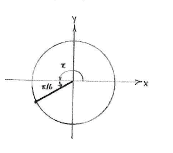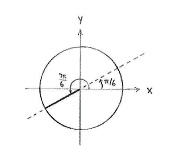Solution 4.2:4e
From Förberedande kurs i matematik 1
(Difference between revisions)
m (Robot: Automated text replacement (-[[Bild: +[[Image:)) |
m |
||
| (2 intermediate revisions not shown.) | |||
| Line 1: | Line 1: | ||
| - | {{ | + | If we write the angle <math>\frac{7\pi}{6}</math> as |
| - | + | ||
| - | {{ | + | {{Displayed math||<math>\frac{7\pi}{6} = \frac{6\pi+\pi}{6} = \pi + \frac{\pi }{6}</math>}} |
| + | |||
| + | we see that the angle <math>7\pi/6</math> on the unit circle is in the third quadrant and makes an angle <math>\pi/6</math> with the negative ''x''-axis. | ||
| + | |||
[[Image:4_2_4_e1.gif|center]] | [[Image:4_2_4_e1.gif|center]] | ||
| + | |||
| + | Geometrically, <math>\tan (7\pi/6)</math> is defined as the slope of the line having an angle <math>7\pi/6</math> and, because this line has the same slope as the line having angle <math>\pi/6</math>, we have that | ||
| + | |||
| + | {{Displayed math||<math>\tan\frac{7\pi}{6} = \tan\frac{\pi}{6} = \frac{\sin\dfrac{\pi }{6}}{\cos\dfrac{\pi }{6}} = \frac{\dfrac{1}{2}}{\dfrac{\sqrt{3}}{2}} = \frac{1}{\sqrt{3}}\,\textrm{.}</math>}} | ||
| + | |||
[[Image:4_2_4_e2.gif|center]] | [[Image:4_2_4_e2.gif|center]] | ||
Current revision
If we write the angle \displaystyle \frac{7\pi}{6} as
| \displaystyle \frac{7\pi}{6} = \frac{6\pi+\pi}{6} = \pi + \frac{\pi }{6} |
we see that the angle \displaystyle 7\pi/6 on the unit circle is in the third quadrant and makes an angle \displaystyle \pi/6 with the negative x-axis.
Geometrically, \displaystyle \tan (7\pi/6) is defined as the slope of the line having an angle \displaystyle 7\pi/6 and, because this line has the same slope as the line having angle \displaystyle \pi/6, we have that
| \displaystyle \tan\frac{7\pi}{6} = \tan\frac{\pi}{6} = \frac{\sin\dfrac{\pi }{6}}{\cos\dfrac{\pi }{6}} = \frac{\dfrac{1}{2}}{\dfrac{\sqrt{3}}{2}} = \frac{1}{\sqrt{3}}\,\textrm{.} |


